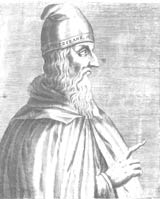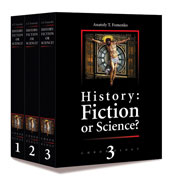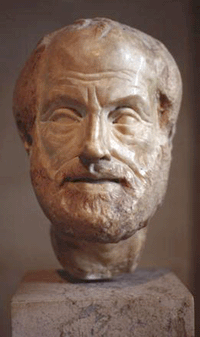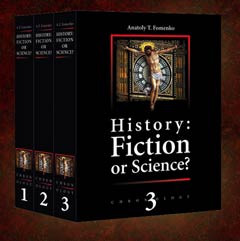|
"All men by nature desire knowledge"
Aristotle, more than any other thinker, determined the orientation and the content of Western intellectual history. He was the author of a philosophical and scientific system that through the centuries became the support and vehicle for both medieval Christian and Islamic scholastic thought: until the end of the 17th century, Western culture was Aristotelian. And, even after the intellectual revolutions of centuries to follow, Aristotelian concepts and ideas remained embedded in Western thinking. We suggest that modern bussiness code ethics is grandfathered by Aristotle. The limited space of our page does not allow for famous quotes by philosophers. It does not hold the answer to ethics of human cloning or biography of Aristotle.
Does the Earth Move?
In the 4th century BCE, Aristotle organized all of classical science and defined its methodology. His writings became the core of learning in Western culture through the middle ages. Aristotle affirmed the geometric model of Plato, and even added to the many spheres of Eudoxus, although Aristotle denied the harmony of the spheres. He thought that any sound made by a body as large as the moon would be deafening.
Aristotle contrasted the nature of the heavens (the superlunary realm, above the orbit of the moon) with the nature things on earth. The four elements in the sublunar realm are fire, air, earth, and water. Earthly matter is changeable; it experiences generation and decay. Its natural motion is to fall on a straight line if heavy, or rise toward the moon on a straight line, as smoke from a fire. The motion of earthly matter terminates when it reaches its natural place.
Everything in the heavens is made of just one perfect element, aether, which is permanent, unchanging and incorruptible; its natural motion is circular and without rest.
The natural places and motions of everything above and below are determined by the intrinsic geometry of an absolute space, and not just by relations among things. Advocates of a moving earth will therefore need to supply a new theory of motion.
 Although most Greek philosophers agreed that the earth is at the center of the universe, Aristarchus of Samos (3rd century BCE) is a notable expception, the more so because he became the head of the Peripatetic school. Aristarchus believed that the earth orbits the sun; he assumed that the distance to the stars is so great that the size of earth's orbit is as nothing compared to it. For his heliocentric views, Aristarchus was accused of impiety. (Copernicus knew about Aristarchus, but, perhaps nervous about the ancient charges of impiety, never mentioned him in De revolutionibus.)
In the 2nd century BCE, the Greek astronomer Ptolemy of Alexandria refined the geocentric model of Pythagoras and Plato using epicycles, that is, circles riding on circles, to account for retrograde motion of the planets.
Although most Greek philosophers agreed that the earth is at the center of the universe, Aristarchus of Samos (3rd century BCE) is a notable expception, the more so because he became the head of the Peripatetic school. Aristarchus believed that the earth orbits the sun; he assumed that the distance to the stars is so great that the size of earth's orbit is as nothing compared to it. For his heliocentric views, Aristarchus was accused of impiety. (Copernicus knew about Aristarchus, but, perhaps nervous about the ancient charges of impiety, never mentioned him in De revolutionibus.)
In the 2nd century BCE, the Greek astronomer Ptolemy of Alexandria refined the geocentric model of Pythagoras and Plato using epicycles, that is, circles riding on circles, to account for retrograde motion of the planets.
The switch from spheres to circles and epicycles had been initiated by Apollonius, the conics expert, and developed by Hipparchus, author of the first known star atlas. The circles made the astornomer's work of calculating manageable; at that time "calculating" meant complex and painstakingly accurate constructions with compass and straight edge.

The Metamorphoses
The Metamorphoses or Golden Ass is touted as the only surviving work of literature from the ancient Greco-Roman world.
It relates the ludicrous adventures of one Lucius, who experiments in magic and is accidentally turned into an ass.
Numerous amusing stories, many of which seem to be based on actual folk tales, with their ordinary themes of simple-minded husbands, adulterous wives, and clever lovers, as well as the magical transformations that characterize the entire novel, are included within the main narrative.
The longest of these inclusions is the tale of Cupid and Psyche: The goddess Aphrodite (in Roman mythology, Venus), jealous of the beauty of a mortal woman named Psyche, asked her son Eros (in Roman mythology, Cupid) to use his golden arrows to cause Psyche to fall in love with the ugliest man on earth. Eros agreed but then fell in love with Psyche on his own, or by accidentally pricking himself with a golden arrow.
Driven by curiosity Psyche frightens away her godly lover. Adventures follow one another but love triumphs in the end as Zeus endows Psyche with immortality and marries her to Eros.
The Golden Ass text is a precursor to the imaginative, irreverent, and amusing literary genre of the picaresque novel in which Rabelais, Boccaccio, Cervantes, Voltaire, Defoe and many others have succeeded.
The 'Classical ass story' surfaced only in Renaissance.
The main plots of it had been developed 200 years earlier by the troubadours.
The Golden Ass is a logical conclusion a mediaeval cycle.
This book will change your perception of History forever!
What if Ancient Rome, Greece and Egypt were invented during Renaissance?
What if The Old Testament was a rendition of events of the Middle Ages?
What if Jesus Christ was born in 1053 and crucified in 1086 AD?
Sounds Unbelievable?
Not after you've read 'History: Fiction or Science?' by Anatoly Fomenko, the leading mathematician of our time.
|






 View movies about ancient Rome!
View movies about ancient Rome! 
